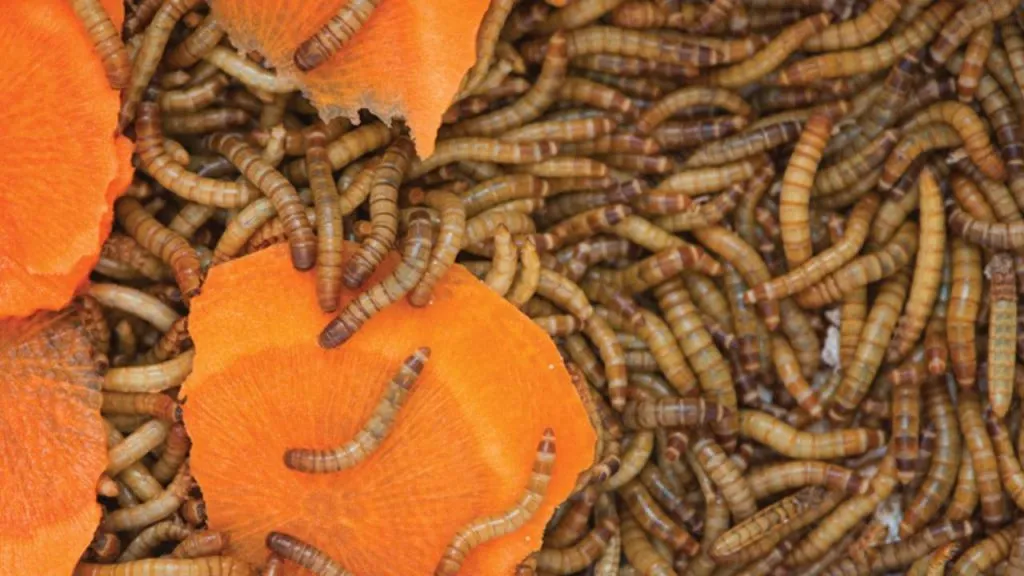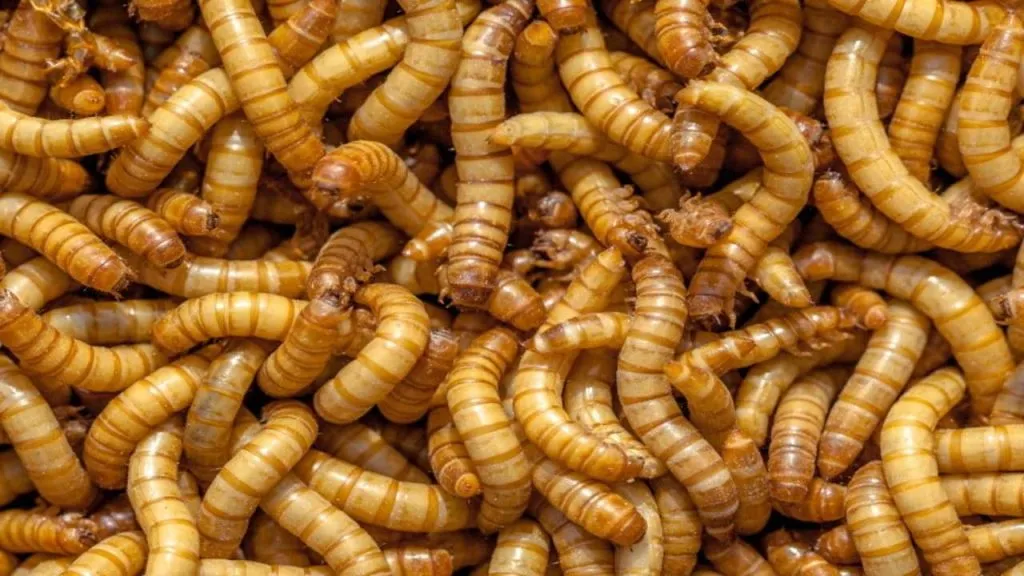As an Amazon Associate I earn from qualifying purchases.
Mealworms are incredibly valuable worms to keep because they serve as food for many other animal species such as lizards and fish.
These worms are the larval stage of the mealworm beetle.
During their life cycle, they go through various phases: they hatch from eggs, then become larvae known as mealworms, and finally transition into pupae before becoming adult beetles.
Typically, mealworm larvae are about 2.5 cm long, making them an ideal food source for numerous animals and pets.
This is why they’re commonly found in pet stores. But what exactly do mealworms eat?
Whether in the wild or captivity, mealworms have a diverse diet that supports their growth and development.
In this blog post, we’ll delve into their eating preferences and habits both in natural habitats and controlled environments.
What Do Mealworms Eat In The Wild: The Complete List of Food

In the wild, mealworms, have a wide-ranging diet because they’re omnivores, which means they eat both plants and animals.
Their diet includes:
- It is decaying organic matter like fallen leaves, fruits, and vegetables, which they find on the forest floor or in agricultural fields. This helps them break down plant material and return essential nutrients to the soil.
- Fungi and molds that grow on decaying organic matter. Mealworms play a part in breaking down fungal structures, aiding in decomposition.
- Smaller insects and their larvae live in decaying matter, such as flies, beetles, and other bugs. They scavenge on dead animals like insects, worms, and small vertebrates, which helps in the natural breakdown of organic waste.
- Grains like wheat, corn, oats, and others are found in barns and mills. They readily consume these grains.
- Rotting wood and bark, where they extract nutrients from decaying plant material, contributes to nutrient recycling in forest ecosystems.
- In moist environments, they may consume algae and various microorganisms found in decaying matter, which assists in nutrient cycling and decomposition processes.
- Under certain conditions, mealworms may even eat the roots and tissues of living plants, especially if the plants are weakened or decaying.
Mealworms play a significant role in the ecosystem by helping break down organic matter, recycling nutrients, and contributing to the balance of the various ecosystems they inhabit.
Now that we’ve looked at what mealworms eat in their natural habitat, let’s dive into the different foods that various types of mealworms prefer.
What Do Yellow Mealworms Eat?
The Yellow Mealworm, scientifically known as Tenebrio molitor, is perhaps the most familiar species among mealworms.
They are omnivorous, which means they eat a variety of plant and animal-based foods.
In their diet, Yellow Mealworms primarily consume grains, cereals, fruits, vegetables, and decaying plant material.
When kept in captivity, they can be nourished with foods like wheat bran, oats, carrots, potatoes, and similar items to maintain their health.
Sometimes, they may also consume other insects.
Due to their ease of cultivation and study, Yellow Mealworms are often chosen as subjects for scientific research and educational purposes.
Their adaptable nature and widespread availability make them valuable for exploring various aspects of biology and ecology.
What Do Darkling Beetle Eat?
The Darkling Beetle, resembling the Yellow Mealworm in appearance, is another type of mealworm that has numerous similarities in behavior and traits with its yellow counterpart.
Their diet closely resembles that of Yellow Mealworms, consisting of grains, cereals, decaying plant matter, and other organic substances commonly found in their surroundings.
However, it’s important to note that Darkling Beetles encompass various species, each with its own dietary preferences.
Some species primarily act as detritivores, which means they feed on decaying organic matter.
On the other hand, some species may lean towards being herbivorous, preferring to consume plants and vegetation instead.
The diversity in their diet reflects the wide range of ecological roles that Darkling Beetles play in different ecosystems.
What Do Superworms Eat?
Superworms, scientifically known as Zophobas morio, are notably larger than Tenebrio species, making them a preferred choice among some reptile owners for feeding.
Their substantial size and nutritional value make them appealing for reptile diets.
In terms of diet, Superworms share similarities with Yellow Mealworms and Darkling Beetles.
They consume a variety of foods including seeds, grains, fruits, vegetables, and decaying organic matter.
When kept in captivity, they are commonly fed with nutritious items such as oats, carrots, apples, and potatoes to ensure they receive optimal nutrition for their well-being.
Recognizing the distinctions among these mealworm species holds significance for a range of purposes, such as pet care, scientific studies, and farming methods.
Each species might have unique needs and behaviors that should be taken into account when handling them in different situations.
Learning about what different types of mealworms like to eat helps us understand how varied these interesting bugs are.
Now, let’s talk about what mealworms eat when they’re kept in captivity.
What Do Mealworms Eat in Captivity: What Can I Feed?
Mealworms kept in captivity are not choosy eaters and will happily devour a variety of foods to stay healthy. Here’s what you can offer them:
1. Dry Grains: Mealworms readily consume grains as a staple part of their diet, which provides vital nutrients.
Options include oatmeal (rolled or quick-cook), wheat bran, cornmeal, barley, and crushed crackers or bread, all of which offer essential carbohydrates and fiber.
2. Fruits and Vegetables: You can provide mealworms with a range of fruits and vegetables such as apples, carrots, broccoli, zucchini, potatoes (peeled), sweet potatoes, lettuce, oranges, bananas, squash, and leafy greens.
These foods supply essential vitamins, minerals, and moisture.
3. Commercial Mealworm Feed: Specialized mealworm feeds designed to meet their nutritional needs are available in pet stores and online, offering convenient feeding options.
4. Dry Pet Food: In moderation, mealworms can also consume some dry pet foods like dog or cat food.
Look for options low in fat and moisture content.
Additionally, cooked and chopped chicken or fish in small amounts can be offered.
5. Calcium Supplements: Strengthen mealworms’ exoskeletons and support their overall health by providing calcium supplements such as crushed eggshells or calcium powder.
By offering a varied diet that includes these food options, you can ensure the well-being and vitality of your captive mealworms.
What Do Mealworms Not Eat?
Mealworms have preferences and instincts that guide them away from certain foods or substances that might harm them:
1. Processed Foods: They steer clear of processed foods like sugary snacks, candies, and processed meats.
These foods can be harmful and challenging for them to digest.
2. Citrus Fruits: Mealworms avoid citrus fruits such as oranges, lemons, and grapefruits because the high acidity can upset their digestive systems.
3. Spicy or Seasoned Foods: Mealworms aren’t fans of spicy or heavily seasoned foods, which can cause discomfort or negative reactions in their delicate digestive systems.
4. Dairy Products: Foods like cheese, milk, and yogurt aren’t on the mealworm menu due to their lactose content and high moisture levels.
These can lead to digestive issues and mold growth in their environment.
5. Toxic Plants or Chemicals: Mealworms instinctively steer clear of toxic plants or chemicals that could harm them.
It’s crucial to keep their surroundings free from pesticides, herbicides, and other harmful substances that they might accidentally ingest.
By steering clear of these items and providing a nutritious diet, you can help keep your mealworms healthy and thriving in captivity.
How Do Mealworms Find Their Food: The Hunting Method

Mealworms don’t actively hunt down their food like predators do. Instead, they depend on their sharp sense of smell and touch to find food nearby.
When mealworms sense food around, they use their sensitive antennae and mouthparts to explore and move toward it.
Their way of finding food is more like passive foraging. Mealworms wander around their surroundings, exploring different surfaces and areas until they catch the scent or chemical signals of potential food.
Once they pick up on these cues, they investigate further by nibbling and testing the food with their mouthparts to make sure it’s suitable to eat.
In simple terms, mealworms rely on their senses and exploration to locate food rather than actively hunting for it.
Their excellent sense of smell and touch leads them to sources of nourishment, helping them survive in their environment.
Conclusion
To sum up, mealworms are fascinating creatures with a varied diet that helps them play important roles in nature and thrive in captivity.
Knowing what they like to eat and how they eat is vital for pet owners, educators, and those involved in commercial breeding.
By giving them a healthy and diverse diet, we can keep these hardworking larvae happy and healthy, and recognize their significance in the ecosystem.
FAQ’s:
Mealworms need a few key things to survive: a suitable environment with a bedding material like oats or bran, food such as fruits, vegetables, or grains, and proper ventilation to prevent mold and maintain air circulation.
Mealworms don’t drink water like we do.
Instead, they get their moisture from the foods they eat.
However, providing a small dish of water or hydrating foods like fruits and vegetables can help keep them healthy.
The lifespan of mealworms depends on various factors like temperature, humidity, and food availability.
Typically, mealworms can live for several months to a year or longer under ideal conditions.
Mealworms undergo a remarkable transformation called metamorphosis.
They start as tiny eggs, hatch into larvae (mealworms), and then pupate into a dormant stage known as pupae.
Finally, they emerge as adult beetles.
This life cycle from egg to adult usually takes a few months.
Amazon and the Amazon logo are trademarks of Amazon.com, Inc, or its affiliates.

